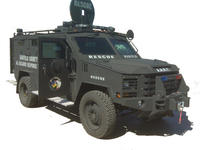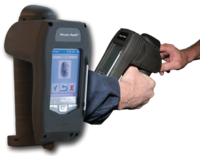-
U.S. spends $90 billion on border security, drugs keep pouring in
A recent study found the United States has spent an estimated $90 billion over the past decade to secure the U.S - Mexico border with mixed results;annual border spending had tripled over the last decade; the increased spending has helped curb illegal immigration, but for Mexican drug cartels business is booming and they are smuggling more drugs than ever into the United States
-
-
SWAT Team in Washington acquires heavily armored vehicle

The Tri-City Regional SWAT Team in Tacoma, Washington recently received a major boost to its arsenal of crime fighting tools;thanks to DHS grants, the Tri-City Regional Swat Team was able to purchase the BearCat, a $292,000 armored personnel carrier; the vehicle is heavily armored and is capable of stopping .30-caliber ammunition
-
-
Wireless fingerprint readers help police fight crime

Using a new wireless device, police across the country are now able to quickly and accurately identify a suspect in the field; using RapID, a small handheld unit, officers can read a suspect’s fingerprint and check it against a database for any matches; if any matches are found the device will pull up the person’s real name, date of birth, gender, and race, making it more difficult for criminals to use a false identity
-
-
DHS urges greater vigilance for Independence Day, but no threats
As Americans across the United States prepare to celebrate the nation’s birth on 4 July, DHS is urging law enforcement agencies and individuals to remain vigilant; in its latest Security Awareness bulletin, DHS is careful to note that there is no “specific or credible information” that al Qaeda is planning an attack, but did say that al Qaeda had aspired to execute attacks on the symbolic holiday
-
-
Documents reveal drug cartels' secret weapons, techniques

The recent attack on Arizona’s Department of Public Safety by LulzSec has revealed that law enforcement officials in the Southwest are battling drug cartels that use a variety of sleek gadgets and hidden weapons; the sensitive documents published by LulzSec show that smugglers have become increasingly clever using a variety of methods to sneak drugs past border officials; the cartels have hollowed out cell phones to plant 180,000 volt stun guns or a .22 caliber pistol
-
-
New radar gun spots tailgaters
Tailgating has long been a dangerous practice causing many fatal highway accidents, yet law enforcement agencies have struggled to effectively enforce the law as they lacked the proper equipment to document and prosecute violators;without definitive proof, cases involving tailgating were difficult to win in court, but a Colorado based company may have sold this problem; Laser Technology Inc. (LTI) has developed a device it calls Distance Between Cars (DBC)
-
-
Supreme Court to hear GPS tracking case
The 220-year old Fourth Amendment to the Constitution offers protection against unreasonable searches; the Supreme Court agreed to hear a case involving the police secretly attaching a GPS device to a suspect’s car to monitor his movement; the question before the Court: does the secret placement of a GPS device on a suspect’s car in order to keep tabs on him for an extended period of time require a search warrant
-
-
Battle over gun microstamping bill heats up in New York

New York is locked in a fierce political battle over proposed legislation that would require all guns sold and manufactured in the state to use “microstamping” technology; law enforcement officials favor the bill as it would provide investigators with valuable leads; Pro-gun advocates have staunchly opposed microstamping stating that the technology is flawed, threatens the rights of gun owners, and is expensive
-
-
Arizona police network latest LulzSec cyber victim
In the latest string of attacks on government computer networks by LulzSec, an international hacker network, the Arizona Department of Public Safety’s computer network was broken into and the group is publicly releasing hundreds of law enforcement documents
-
-
Marine reservist arrested outside Pentagon, suspicious vehicle found

Authorities apprehended Lance Corporal Yonathan Melaku early Friday morning after he was found at Arlington National Cemetery while it was still closed; authorities discovered that the suspect was carrying a notebook that contained the phrases “al Qaeda,” “Taliban rules,” and “Mujahid defeated croatian forces”; law enforcement officials say that despite the evidence found, Melaku is not believed to be involved in a terrorist plot
-
-
ShotSpotter raises $10.5 million
On Thursday, ShotSpotter, Inc., the manufacturers of gunshot location and detection technology, announced that it had raised $7 million in equity and expanded its credit facility by $3.5 million; with the additional funds, ShotSpotter will expand its flagship product the ShotSpotter GunSpotter Location System in international markets
-
-
N.Y. Dems push for gun microstamping legislation
New York legislators are pushing for new gun technology that could help law enforcement officials fight crime; microstamping is a new technique that stamps a code on shell casings ejected when a gun is fired; the code can provide valuable information like the dealer who sold it and the buyer who purchased it; this week marks the end New York’s current legislative session and Democratic lawmakers are pushing to get the Republican controlled Senate to take up a bill that would require guns in New York to be microstamped
-
-
Technology helps law enforcement predict threats -- and prepare for them
3i-MIND is the LEIM 2011 event to show its technology — a family of configurable solutions which help law enforcement agencies gather and analyze open-source and other intelligence in order to predict and prepare for threats; the technology uses deep-Web tools to access leads found only in social networks, chat rooms, and online forums
-
-
New powertrain improves fuel economy, adds hp Chevrolet Impala Police
GM says that a new 3.6L V-6 engine and a 6-speed automatic transmission achieves 302 hp and an estimated fuel economy of 17 mpg city and 27 mpg highway — a 3 mpg advantage over previous Impala models and 28 percent better than the Ford Crown Victoria; the 2012 Impala can accelerate from 0-60 mph in 6.6 seconds, based on GM engineering tests
-
-
Apple cracks down on drunk driving evasion apps
At the urging of several U.S. senators, Apple recently announced that it would no longer sell apps that were designed to inform users about police checkpoints for drunk drivers; the senators lauded the move, but said that the company should also remove existing apps from its stores rather than just preventing new ones from going on sale; the senators were targeting apps like PhantomALERT which taps into a phone’s GPS device and alerts the driver of any active law enforcement zone including checkpoints, speed cameras, and speed traps
-
More headlines
The long view
How Male Grievance Fuels Radicalization and Extremist Violence
By Haily Tran
Social extremism is evolving in reach and form. While traditional racial supremacy ideologies remain, contemporary movements are now often fueled by something more personal and emotionally resonant: male grievance.
